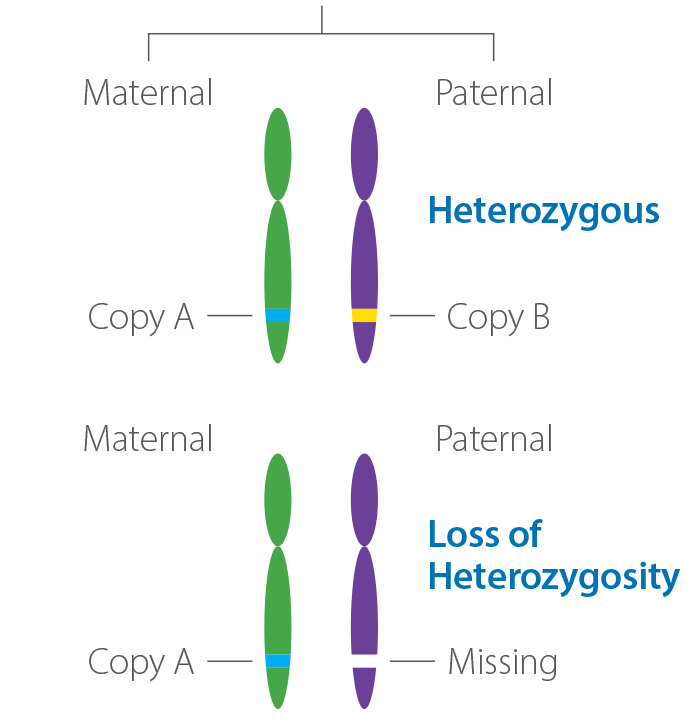Loss of Heterozygosity
Genomic Loss of Heterozygosity or genomic instability is often related to defective homologous recombination repair mechanisms.
Loss of Heterozygosity (LOH)
Genomic Signatures
| Biomarker | Method | Analyze | Result |
|---|---|---|---|
| Genomic Loss of Heterozygosity (LOH) | Seq | DNA-Tumor | High-38% of tested genomic segments exhibited LOH (assay threshold is ≥ 16%) |
What is Loss of Heterozygosity (LOH)?
- Normally, there are 2 copies of every gene in a person’s DNA (excluding sex chromosomes in males)
- When the copies are not identical, the person is considered heterozygous at that gene location
- In cancer, DNA damage events can occur in the cell that causes the loss of one copy
- In the second example shown here, the cell has lost copy B and, therefore, is no longer heterozygous at this location.
- LOH can occur at the single-gene level or genome wide – which is called Genomic LOH
- Single-gene level: In a person heterozygous for a tumor suppressor gene (one functional copy and one disabled copy), the loss of the functional copy can lead to cancer, as the person no longer has a working version of the tumor suppressor.
- Genome-wide: When a person has lost a critical gene involved in DNA repair, chromosome deletions can appear throughout the genome, resulting in LOH at thousands of locations. Even if the DNA repair gene alteration is missed in testing, the detection of genomic LOH can identify a tumor that may be susceptible to drugs that impact the DNA-damage/repair pathway (PARP inhibitors or platinum agents).
- The Caris assay measures genomic LOH in order to identify cases of potential homologous recombination deficiency that are not identified with standard NGS.
Homologous Chromosomes

The cell has lost copy B and, therefore, is no longer heterozygous at this location.
Caris Molecular Profiling Menu by Region
United States
Review and download the Caris molecular profiling testing menu for United States cases.
New York
Review and download the Caris molecular profiling testing menu for New York state cases.
International*
Review and download the Caris molecular profiling testing menu for International cases.
*Excluding EEA, EU, CH countries.
Caris Molecular Profiling Menu by Region
International & US
New York
European Union (EU)
Please complete the form below to have a Caris Scientific Rep (Molecular Science Liaison) contact you directly.
"*" indicates required fields
Order Profiling
Place an order today for a comprehensive, personalized Caris profiling report.